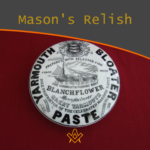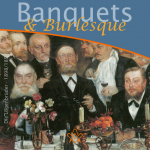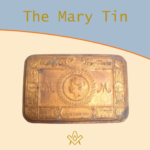John Coleman Blanchflower was initiated in Walpole Lodge, No. 1500, Norwich, on 2 December, 1875, age 28. He gave his occupation as ‘merchant’.
In 1877, he joined the Lodge of Friendship, No. 100, Great Yarmouth.
A Timothy Coleman Blanchflower (aged 28 – presumably a relative) was also initiated in Walpole Lodge on the same day: noted as a purveyor of ‘sauce’ to masons!
Pastes and Potions
In the mid-19th century various medicinal pastes and edible relishes were sold in small earthenware pots with products depicted on the lids.
Soon it became clear that as a marketing tool the ‘pictorial’ lid was an attraction and would lead to better sales as people bought to attain the lid especially when a series was produced.
The ‘Shakespeare Six’ series was very popular along with many other topical and historical subjects, as well as foreign and oriental scenes. Personalities including Royalty were also produced and sought after.
Initially, the black and white printed contents lids were necessary to validate the contents, some of which could be refilled at the local chemist, but soon the pictorial coloured ones took over in popularity and contents manufacturers were quick to join the fray. Staffordshire pottery became premier of its kind.
The early monochrome ones depicting bears were plentiful as ‘bears grease’ was deemed to be a hair restorative and a necessity among the menfolk.
This was driven by a belief that bears had very fine fur and the rendered down carcasses of the animals made into a salve would be an elixir for the scalp.
The populations of North American and Russian brown and black bears became decimated by hunting for this vain purpose.

Pratt (F. & R. Pratt & Co. Ltd)

“Portrait of Felix Edwards Pratt, 1813-1894.” . Accessed November 5, 2022
IMAGE LINKED: New York Public Library Digital Collections Attribution 4.0 International (CC BY 4.0)
Being the premier earthenware manufacturer at the Fenton Potteries, and then at other factories in the Staffordshire Potteries, Felix Edward Pratt (1813-1894) and Richard Pratt founded in the early 19th century the company that was to become an important manufacturer of domestic earthenware and polychrome transfer printed pot lids.
The company was acquired by H. T. Robinson, probably in 1916, and from 1920 it was a subsidiary of Robinson’s Cauldon Potteries Ltd operating from that company’s Cauldon Place Works.
F. & R. Pratt & Co. was one of the subsidiaries acquired by Harrison & Son (Hanley) Ltd when they purchased Cauldon Potteries Ltd from its bankruptcy in 1933.
The F. & R. Pratt & Co. business operated from the Harrison’s Crescent Pottery (George Jones & Sons Ltd) from 1936 until 1958 when the Pratt name and intellectual property were acquired by E. Brain & Co. Ltd.
In 1967, Wedgwood purchased the E. Brain & Co. Ltd business acquiring the right to the Pratt name and patterns.
In the 19th century, the Pratt name was associated with the fine, usually multi-coloured, transfer printed engravings used to decorate the lids of earthenware pots used for food, pharmaceutical products, and toiletries.
The business also produced domestic earthenware including relief moulded earthenware (especially jugs) and tableware with underglaze, multi-coloured decoration (‘Prattware’).
Whilst Felix Pratt was the commercial driving force behind the business, the artist was a Jesse Austin who joined Pratt in the early-1840s.
He was an accomplished watercolour artist and engraver and over nearly 40 years, the business produced over 550 polychrome prints used to decorate the pot lids. Pratt’s first under-glaze, polychrome pot lid was made in 1847 and was a scene ‘Grace before Meals’.
Austin’s subjects included royalty, famous people, City scenes, including eleven views of London.

Garibaldi, welcomed by crowds upon his arrival in London in 1864. The Illustrated London News, 23 April 1864.
IMAGE LINKED: wikimedia Attribution 4.0 International (CC BY 4.0)
Freemasons, Monarchs, and Politicians in Pot Culture
The Masonic Revolutionary
In April 1864, the Italian patriot Guiseppe Garibaldi arrived in Britain. His leadership of the Expedition of the Thousand in southern Italy in 1860, had already captivated public opinion. On his arrival Garibaldi was greeted by vast crowds, he met the Prince of Wales and dined with the nobility and members of parliament.
He also had meetings with exiled revolutionaries based in London, with ordinary working men and with those who had fought alongside him in the struggle for Italian unification.
His visit was a milestone for the Italian community in London. Garibaldi’s ‘celebrity’ was marked by the response of contemporary media, the production of souvenirs and the preservation of memorabilia.
Garibaldi, a respected Mason, whose sword to this day adorns Lodge Italia No. 2687. He was elected as Grand Master of the Grand Orient of Italy in 1867.

Guiseppe Garibaldi immortalised on souvenirs pots of the day.
(Above: Right) Sir Robert Peel (1788-1850) British Conservative Statesman (serving twice as Prime Minister), and ‘father’ of modern British policing, as founder of the Metropolitan Police Service. Shown here to commemorate his death in 1860, after a riding accident in Hyde Park, London.
Albert Edward, HRH The Prince of Wales, and Grand Master (1874 – 1901) – later Edward VII – on one of his foreign tours, visiting the Tomb of Washington in 1860.

Garibaldi, welcomed by crowds upon his arrival in London in 1864. The Illustrated London News, 23 April 1864.
IMAGE LINKED: wikimedia Attribution 4.0 International (CC BY 4.0)
Above: Albert, Prince Consort, (top) was pictured after his death in 1861, but the contents of the pot, probably relish, remain unknown. The young Queen Victoria was depicted on a pot of ‘cherry toothpaste’!
Conclusion
The Victorian era was one of expansion and development and none more so than in the production of pottery, much for display but the bulk for commercial and industrial use.
The most popular display type shows the life, times and achievements of the day; it is surprising that the square & compasses is not seen at all, and obliquely very rarely, evidencing Freemasons’ desire for the secrecy they relish.

Images: unless otherwise credited, are from the author’s personal collection.
Article by: Paul Gardner

Paul was Initiated into the Vale of Beck Lodge No 6283 (UGLE) in the Province of West Kent, England serving virtually continuously in Office and occupying the WM Chair on three occasions.
Paul joined Stability Lodge No 217 in 1997 (UGLE) and now resides with Kent Lodge No 15, (UGLE) the oldest Atholl Lodge with continuous working since 1752, where he was Secretary and now Assistant Secretary and archivist, having been WM in 2002.
In Holy Royal Arch he is active in No 15 Chapter and Treasurer of No 1601, which was the first UGLE Universities Scheme Chapter in 2015.
He was Secretary of the Association of Atholl Lodges which maintains the heritage of the remaining 124 lodges holding ‘Antients’ Warrants and has written a book on Laurence Dermott. - https://antients.org
Recent Articles: by Paul Gardner
 Exchanged the Sceptre for the Trowel Explore the intriguing history of Royals and Freemasonry following the new Monarch's Coronation. From Prince Albert's initiation to the influence of George II and beyond, discover why royalty has long exchanged the sceptre for the trowel, shaping society and maintaining power through this ancient craft. |
 Unearth the mystic origins of Freemasonry in 'That He May Be Crafted.' Paul Gardner explores the symbolic use of working tools from the earliest days of this secret society, revealing a time when only two degrees existed. Delve into this fascinating study of historical rituals and their modern relevance. |
 Paul Gardner looks to a time when politics and Masonry were not precluded, but shush! This was London Masons and the Spitalfields Act of 1773-1865. |
 That rank is but the guinea’s stamp, the man himself’s the gold. But what does this mean, even given the lyric and tone of Burns’ time? It is oft times used in a derogatory sense, (somewhat in good humour) between Masons (or not) on the achieving of honours. But its antecedents are much more complex than that. |
 John and Timothy Coleman Blanchflower were initiated in Walpole Lodge, No. 1500, Norwich England on 2 December 1875; noted as a purveyor of ‘sauce’ to masons! |
 Jacob’s Ladder occupies a conspicuous place among the symbols of Freemasonry being on the First Degree Tracing Board, the most conspicuous and first seen by the candidate on his initiation – a vision of beauty and intrigue for the newly admitted. |
 During a detective hunt for the owner of a Masonic jewel, Paul Gardner discovered the extraordinary life of a true eccentric: Dr William Price, a Son of Wales, and a pioneer of cremation in Great Britain. Article by Paul Gardner |
 Paul Gardner tells the story of his transition from one rule book to another – from the Book of Constitutions to the Rule Book for Snooker! |
 Due or Ample Form? What is ‘Ample’ form, when in lodges the term ‘Due’ form is used? |
 The Butcher, the Baker, the Candlestick Maker Paul Gardner explores the Masonic link between provincial towns’ craftsmen, shop keepers and traders in times past. Many remain in the modern era and are still to be found on the high street. |
 Masonic dining and banquets, at least for the annual Investitures, were lavish, and Kent Lodge No. 15, the oldest Atholl lodge with continuous working from 1752, was no exception. |
 The ‘cable-tow’ or ‘noose’ is used in Craft Masonry as part of the ritual, as are ropes and ties in other degrees - but what does it symbolise? |
 Paul Gardner reflects on those days of yore and the “gentleman footballer” in Masonry |
 What is the Masonic connection with the 1914 Christmas Mary Tin |
 That Takes the Biscuit - The Patriot Garibaldi Giuseppe Garibaldi Italian general and politician Freemason and the Grand Master of the Grand Orient of Italy. |
 W.Bro. Paul Gardner looks at a mid 19th century artefact and ponders ‘Chairing’ |
masonic knowledge
to be a better citizen of the world
share the square with two brothers

click image to open email app on mobile device








